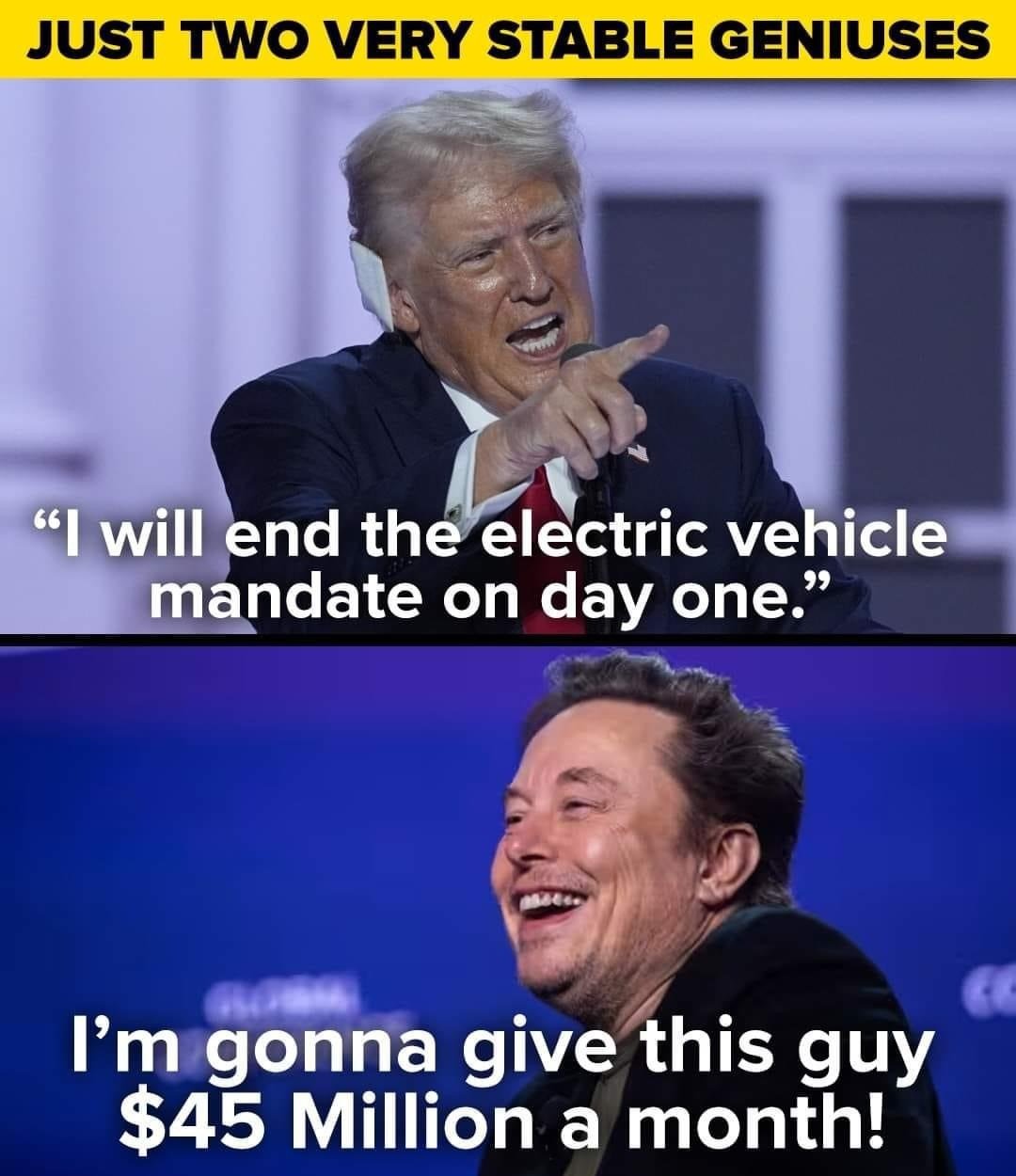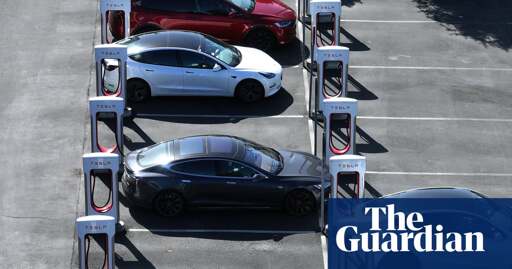Summary
The Trump administration has suspended the $5 billion National Electric Vehicle Infrastructure (NEVI) program, halting state funding for EV charging stations.
The Federal Highway Administration ordered states to stop spending NEVI funds while reviewing program policies. Critics argue the move may violate federal law, as courts have previously blocked similar funding restrictions.
Trump, a vocal EV opponent, also revoked Biden’s 2030 EV sales target.
While existing projects may continue, new approvals are paused, potentially slowing the expansion of charging infrastructure across the U.S.

Just ensuring China owns the future while we drown in the past. Thanks Trump.
Don’t worry, we’ll probably be drowning in the future…
You really shouldn’t upset President Musk like that…
This is a net positive for Musk. Tesla already has an established supercharger network, preventing further investment in the Electrify America charging network means Tesla can continue to control the market and prevent competitors from entering without paying Tesla a massive amount in royalties foe the privilege to use NACS superchargers.
This is the corporate level boomer strategy of pulling the ladder up behind you after you’ve already made it…
holy shit the cucks are doing exactly what is expected, I can believe it
This is mixed news for me. The electric car was never going to save us; it could’ve been a good stepping stone, but the adoption of the technology has been too slow. Don’t get me wrong, I’m not going to spit on progress, I’ll take what I can get, but we’d be much better off prioritizing walkability and good public transit. The really bad news is that there’s nothing replacing this, just more oil.
It’s interesting to see EVs discussed like hybrids (a band-aid that continues to benefit oil biz) as if personal vehicles were ever going to go away entirely. Transitioning off of oil and away from non renewable energy sources alongside walkability and public transit would be ideal, not a single choice or effort.
I think the big problem is we’re building EVs like our current cars, but electric. If you want a halfway decent EV, your only options are big ass SUVs and Crossovers.
Source: a guy who got tired of waiting for Aptera to get to market, and traded in his hybrid coupe for a Mach E.
I don’t disagree, I don’t think we’ll ever be rid of cars, but I think there’s really good evidence to show that we need to significantly decrease car dependency and make walking/biking/transit the default mode as much as possible.
Yes! Absolutely! It’s a personal goal of mine this year! We’ll see how I do with an ebike!
Man, yeah! I really want to get one of those long tail e-bikes so I can take the kids around on it or do grocery runs with it. My SO is skeptical, though, because all of the bike lanes between our house and a grocery store are sketchy AF.
I briefly considered an E-bike to get to work. The tech is now feasible for the range I’d need (15-20 miles one way). I would be fine leaving sooner for the longer time travel. But then I starting mapping out what bike trails and non-highways there are to connect the dots. What I could piece together not only would take much longer with more deviations, it still shared some of the higher speed urban streets that do not have very good lanes for bikes. That was discouraging.
You know how some places have considered using part of an existing highway to create a rail system? What would be cool is if the same idea could be used for a slow traffic lane, protected from the main traffic.
Yeah, I tried pushing that for a storage that cuts through the middle of the city and got the polite version of “fuck off, you crazy person”
That sounds about right, dude. Assuming you’re also American, a lot of our towns and cities aren’t pathed for it, and even where they are you are up against the careless/dangerous or vindictive drivers. Many people see bikes as an obstacle and frustration, and I have seen countless stories about horrific collisions and injuries, it’s very discouraging at least to somebody who didn’t grow up in a bike-friendly area.
Witnessing Amsterdam’s biking masses in person made my heart so happy for them and so sad for us lmao
I’ll take what I can get, but we’d be much better off prioritizing walkability and good public transit.
Those are great for dense urban centers. The only problem is that we have millions of people NOT living on those places that still need transportation.
I would encourage you to consider the case of Switzerland. They have many small villages and towns that are well served by trains and public transit, as many of our small towns once used to be before rail enshittification and car dependency became a thing. In fact, you can still see the walkable history of many cities and towns, especially the small ones, just by visiting old main street. When cars and gas got cheap, we all lost our minds and forgot how to build cities.
Two problems with your argument:
I would encourage you to consider the case of Switzerland.
“The population density in Switzerland is 227 per Km2 (588 people per mi2). The total land area is 39,516 Km2 (15,257 sq. miles). 74.4 % of the population is urban (6,668,094 people in 2025).” source
“The population density in the United States is 38 per Km2 (98 people per mi2). The total land area is 9,147,420 Km2 (3,531,837 sq. miles). 82.8 % of the population is urban (287,421,363 people in 2025).” source
The population density is almost an order of magnitude lower than Switzerland. So while the Swiss model may show a version of success for that population in that geography it doesn’t scale the same way to the USA.
as many of our small towns once used to be before rail enshittification and car dependency became a thing. In fact, you can still see the walkable history of many cities and towns, especially the small ones, just by visiting old main street. When cars and gas got cheap, we all lost our minds and forgot how to build cities.
I don’t disagree that history took a different turn in the early 20th century that dismantled many good public transit options including streetcars and rail, however, even waving a magic wand and getting 100% of that back wouldn’t solve today’s transit needs in the USA. Employment back then was single income workers. Besides seasonal agriculture work, you could generally live close to where you work, and you’d work at the same employer for most of your adult life meaning no need to move. That doesn’t match today’s society with multi-income households, nor the requirement for residential mobility required for frequently changing jobs. Where do you live? Close to one spouse’s work or the other? What if a job change occurs, do you uproot your entire family each time?
This also does nothing to address the requirements of access modern medical services for a population that is living 20 to 30 years longer than those back then. When the life expectancy is 58 years old source, it was more likely that you’d die before reaching geriatric age. An aged loved one of mine has to go to a modern cancer hospital twice a week a 40 minute drive away from home. Thats doable with personal transportation, that same trip might be 3 to 4 hours with 1920/1930’s transpiration and included in that would be lots of walking which isn’t really possible for them over any great distance. The transportation systems of old simply aren’t a drop-in replacement for modern requirements.
Where are they building that Oligark?
Like in Contact. If you know you know.
Or is it just a ship for three that they’re building in plain sight - destination Mars, with seats for Elon, Don, and the economy?
Or a dome? Where they hiding that?








